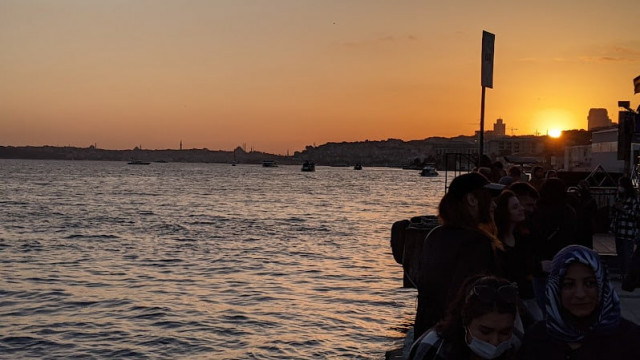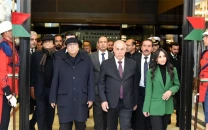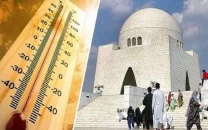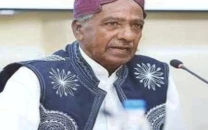If the Bosporus could talk
A popular destination for Pakistanis, more so because of the culture made famous by its entertainment industry

The turquoise expanse of the Bosporus is perhaps one of the most striking features of
Istanbul’s landscape. As you head towards the city centre leaving Ataturk airport behind, the water channel seems like an omnipresence, compelling passers-by to gaze upon its radiance.
Running across Istanbul, separating the East from the West, the Bosporus is truly the point where the twain meet in a fantastic union.
Situated between the Black Sea and the Sea of Marmara, it is the narrowest navigational strait that connects the Mediterranean, the Aegean and the Black Sea through its winding path across Istanbul. The Bosporus has also remained the strategic centre of geo-political upheavals since over a thousand years. Whether it was under the command of the Persian king Darius; navigated by the founder of the Ottoman rule, Mehmet the 1st or dominated by Ataturk during the battle of Gallipoli, the Bosporus has been the centre of cataclysmic changes.
Crossed by countless travellers for centuries past, if it could but speak, it would have many tales to tell ― of victors as well as the vanquished.
For a history buff, Turkey is a dream destination. But for anyone with even a passing interest in history, it offers the mingled flavours of a rich past with abounding art and architecture as well as a progressive present, replete with avant-garde fashions and freeways.
Turkey’s past can be traced from the Palaeolithic age and since then many civilisations from the Greeks to the Persians have had a home there. Subsequently, Alexander’s adventures in the region brought it more recognition and till the days of the Byzantine Empire, its presence on the world map was quite formidable. Its glory was however properly recognised during the Ottoman rule which is by far one of the peak times of Muslim rule, as the Ottoman Empire marked the largest Muslim territory to span the East and the West when at its zenith.
It rivalled the Roman Empire during its glory years particularly from the 14th to the 17th century.
Turkey’s history is much beyond the scope of a few hundred words. From the world’s first temple to the remnants of the Neolithic age and then onto the mosques of the Sultanate of Rum, there are thousands of miles to cover for any archaeologist or historian. A visit to Istanbul would equal merely a step for the average traveller towards the grandeur that Constantinople once had. But that one step too would be quite a giant leap in itself!
To begin with, Istanbul has an uneven terrain and visitors are advised to wear extremely comfortable, walking shoes. Built as a replica of Old Rome, this unique city intrigued Westerners since it was Constantinople and they flocked by sea or land to explore its treasure.
Today, it is still flocked by travellers ― a high average of whom are from Pakistan ― but more so because of the culture made famous by its entertainment industry. And then there’s also the uniqueness of it straddling Europe and Asia which adds the kick for the average desi at a reduced price point. To put it simply, Istanbul is a gorgeous city.
Founded on seven hills with the city walls surrounding them it was once called Nova Roma (new Rome). The hills are visible along the Golden Horn if you take a ride on the Bosporus or if you are crossing over from old Istanbul to the modern side, where the coastline along the Horn is visible from the Ataturk Bridge.
If visiting for a limited number of days (which most of us do), it is best to have a definite plan of which parts of Istanbul are to be visited as that determines the ideal options for lodgings. A week is barely enough to cover all of Istanbul as each district has so many historical edifices to explore. Most tourists on numbered days and a modest budget stick to residing in Sultanahmet ― the oldest locality of Istanbul and the location of most of its historic sites.
Other neighbourhoods within the city such as Tophane, Taksim and Cihangir (in the Beyoglu district, separated from Sultanahmet by the Golden Horn) also have some amazing sites to offer like a Venetian Palazzo and the Doge of Venice`s mansion among others. The last time I visited I went to Ortakoy also and that too is highly recommended for visitors especially to see the sun set on Istanbul.
With limited days, if Sultanahmet is all you can cover, then too Istanbul is worth it. Just within that old city the entire past of Turkey, the Ottoman Empire and the remnants of Constantinople will all come alive.
Built on the first of the seven hills, Sultanahmet has five top of the list sites that every first time travel must see ― the Topkapi Serayi; the Blue Mosque; the Hagia Sophia; the Basillica Cistern and the Dolmabahce Palace.
Ever since the heist film Topkapi, the Museum/Palace has held a lure for many of us. And amongst the artefacts on display within the Topkapi Museum, the bejewelled dagger meant for Nadir Shah also has a special place with the additional information that this was the piece featured in the film.
All the art pieces have such great historic significance that one comes out in a daze after visiting all the galleries. With the architecture typically reminiscent of Ottoman style ― domes upon domes upon domes ― there are hundreds of rooms within but only a few are open to the public. Amongst its treasures are porcelain pottery, Islamic calligraphy manuscripts, royal robes, weaponry, jewellery and thousands of other treasures.
The more noteworthy items belong to the section of Holy Relics which contains the staff of Hazrat Musa (AS), the water bowl of Hazrat Ibrahim(AS), the sword of Hazrat Dawood (AS) and of course, the footprints of the Holy Prophet (PBUH) along with his mantle and swords of his sahabah. There are actually many, many such items and of course none of them can be photographed so one has to record them in memory.
Following the serialising of the Turkish drama – Mera Sultan ― on our local TV, the Topkapi Palace has also gained more awareness and one is more familiar with court life which is what induced me to give the extra fare to visit the Harem attached to the Museum grounds.
It was fascinating to see and pass under the same archways through which the concubines of the Ottoman Sultans walked for their daily learning lessons in court (as seen on the show). That was where Alexandra aka Roxanne aka Hurum Khatoon had reportedly fainted in the Sultan Sulaiyman’s arms to gain his attention and from there on enslaving him to change the destinies of future Sultans.
One note may be made here that visitors are better advised to do prior research of all the places to be visited because information is scant and English is not one of the spoken languages. It is surprising that such a popular destination for tourists and all sorts of other travellers, almost all signs and notices are only in Turkish. Even the locals have the most minimal fluency in English. Just to explain further, it was a near impossible task at a café to ask for milk in my coffee (not a common practice). I had my coffee black ― because, caffeine, duh! ― but I made a point to go to the local store and find out what milk is called. For anyone noting, it’s called ‘Sut’.
Walking up from the Topkapi Palace one arrives at the Hippodrome ― a central complex which has the Hagia Sophia on one side and the Blue Mosque on the other.
The Hagia Sophia is a must visit. It encapsulates the wisdom of two of the world’s most prominent religions ― Islam and Christianity ― and portrays how these can survive in harmony under one roof, or rather, dome.
The massive dome that characterises this Byzantine architecture is another one of those, ‘to be experienced’ places. Even massive seems like an understatement as it makes one feel that it is a portion of the sky under which one is standing.
Now a museum, The Hagia Sophia (pronounced Aya Sofia) is the second most popular site in Turkey. But it wasn’t always this amalgam of religious beliefs. It first served as an Eastern Orthodox cathedral during the middle ages (6th century to the 15th century). For a while it was also converted to a Roman Catholic Church and eventually it was turned into a mosque by orders of the first Ottoman conqueror, Sultan Mehmed II. Upon this conversion, it was shorn of all the Christian relics ― bells, altar, iconostasis, sacrificial vessels and murals depicting Jesus, Mary and other Christian saints. In place of these, a mehrab, myanbar and four minaars were added to turn it into a mosque, which way it remained until 1931 when it was closed and eventually re-opened under Ataturk’s governance as a museum depicting its dual past.
As a museum, it beautifully encapsulates its past with huge calligraphic art adorning the tiny domes, next to the murals of Jesus, Mary and the concepts of Holy Trinity.
A beautifully scripted Allah in Arabic in gigantic point size flanked on four sides by comparably large calligraphy of the names of the four Khalifas dominate the sides of the ceiling which is also surrounded by murals of winged angels. And then there is the Michelangelo style birth of Christ imagery which is as awesome.
If one shifts the gaze downward towards the myanbar, there is the altar standing almost as majestically.
The peace that emanates through the building can almost be touched with finger tips. And one wonders ― why can’t the real world be this beautiful in its tolerance?
The interior walls of the cathedral/mosque/museum are decorated with gold mosaic whereas the floors are white marble.
Situated a little apart from these three primary tourist attractions, is the Dolmabahce Palace which is located at the very edge of the European bank of the Bosporus strait. The shiny blue water mass almost twinkles at the visitors standing in the Palace Gardens, forming perhaps one of the most picturesque backdrops in Istanbul ― especially for photography purposes.
The Palace site was actually an imperial garden in the 18th century from where the Palace gets its name Dolmabahce, meaning, ‘filled-in garden’. As per general web information, “the construction cost five million Ottoman mecidiye gold coins which is 35 tonnes of gold and the approximate equivalent of $1.5 billion in today's values. Reportedly, this sum corresponded to approximately a quarter of the yearly tax revenue of Turkey.
The rooms are as grand as one may imagine and the ceilings are heavily gilded in places. Crystal and gold define its interiors along with the world’s largest Bohemian crystal chandelier which hangs in the ceremonial Hall ― a gift from Queen Victoria.
Dolmabahce palace became the official residence of later Ottoman Sultans in the late 19th and early 20th centuries and was also used as the presidential summer residence by Mustafa Kemal Ataturk who also spent his last years in residence at the Palace where he later died on November 10, 1938.
Ataturk’s bedroom, his wheelchair where he breathed his last, his writing table and the slippers near his bed speak more of history then all the grandeur within the Palace. In fact, it may be said that the outrageously expensive construction of the Palace was perhaps the start of the financial ruin of Turkey when it was forced to declare a state bankruptcy.
The grandeur, the expanding horizons and might of the Ottomans could not withstand the court intrigues of the Royal women and the decadence of the later year Sultans who rendered the monarchy weak. The financial ruin was the last nail as Turkey began being gradually dismantled after World War 1.
If it hadn’t been for Kemal Ataturk ― already the hero of Gallipoli at the time ― Turkey as a strong Asian/European nation would not have remained.
He raised the initiative and defeated the Greek and the English while simultaneously getting rid of the Sultanate to change the remnants of the Ottoman from Sultanate to the Republic of Turkey.
Now, this unique country that straddles more than one continent, ocean and seas is possibly the most historic and strategically crucial centre of the world.
If you had time for just one more site to visit before you leave the city, I would strongly recommend the Basilica Cistern. Besides the fact that the Cistern has been used as the location in films and books ― Dan Brown’s mystery, Inferno is an example – the Basilica Cistern is a space to experience and feel.
A Basilica ― which in earlier days referred to an open palatial ground or the tribunal chamber of kings ― was supposedly the original site of this cistern, from whence it got this name. The cistern was built under the Palace Basilica to provide a water filtration system to the Palace of Constantinople and to the surrounding buildings on the First Hill. As per internet information, 7000 slaves were involved in the construction of these ancient water works. But what an extraordinary piece of construction it is. The moment one descends to this underworld maze of water ducts, it seems that one has stepped into ancient Rome itself and from where Juno might come floating to play mischief on unsuspecting visitors.
The dark tunnels have a stunning symmetry and coupled with the faint sound of water as background music, the vision is truly awe inspiring of the greatness of ancient architects and labourers alike.
The Basilica Cistern continued to filter and distribute water over the centuries, even to the Topkapi Palace during the Ottoman rule and into the modern times.
While history never ends in Istanbul, there is much more that dots the landscape besides historic edifices.
As the sun sets, the large and small chai cafes come alive everywhere in the city, particularly in the entire area of Taksim Square where the cafes serving bakhlava and aromatic teas beckon to everyone with a heady aroma. In flavours like peach, apple, strawberry, etc (all tea is strictly black ― milk and tea together is like blasphemy for a Turk!) the teas are literally divine drinks of the gods! The baklava, in itself a rich sweet is served with huge dollops of creamy ice cream. Calorie counting can wait on this trip.
And then there are the chestnut sellers every few meters selling roasted chestnuts with masala standing next to the small, mussel vendors selling boiled mussels in half split shells with a garnish of lemon.
The quaint trams that run in several directions everywhere across the city, are another part of Istanbul’s cityscape. But beware of pickpockets in these crowded vehicles especially during rush hour ― an advice from one who lost every possible card and cash on the last day before departure.
The only puzzling point was the language barrier. From the airport, which has minimal English directions too within cities, there’s little to no grasp of English. Not even shopkeepers or restaurant/hotel staff who would be dealing with a constant stream of tourists can communicate properly.
On the other hand, it should be commended that they are thriving as an international power without the use of the ‘mighty’ English language. A lesson to be learnt by us who make fun of anyone not versed in our once White Masters’ tongue.
Turkey is perhaps one of the few places left in this world where being a ‘Pakistani’ still brings out warmth and friendliness from the locals and it’s a great feeling. Though I am told that as popular as it gets with Pakistani tourists ― who do what they do wherever they go ― the love is gradually reducing.
We really can’t be trusted with good fortune, can we?
Maheen A. Rashdi is a former magazine editor, and columnist covering social and geo-political issues and can be reached at maheenrashdi@gmail.com. All information and facts provided are the sole responsibility of the writer



















COMMENTS
Comments are moderated and generally will be posted if they are on-topic and not abusive.
For more information, please see our Comments FAQ